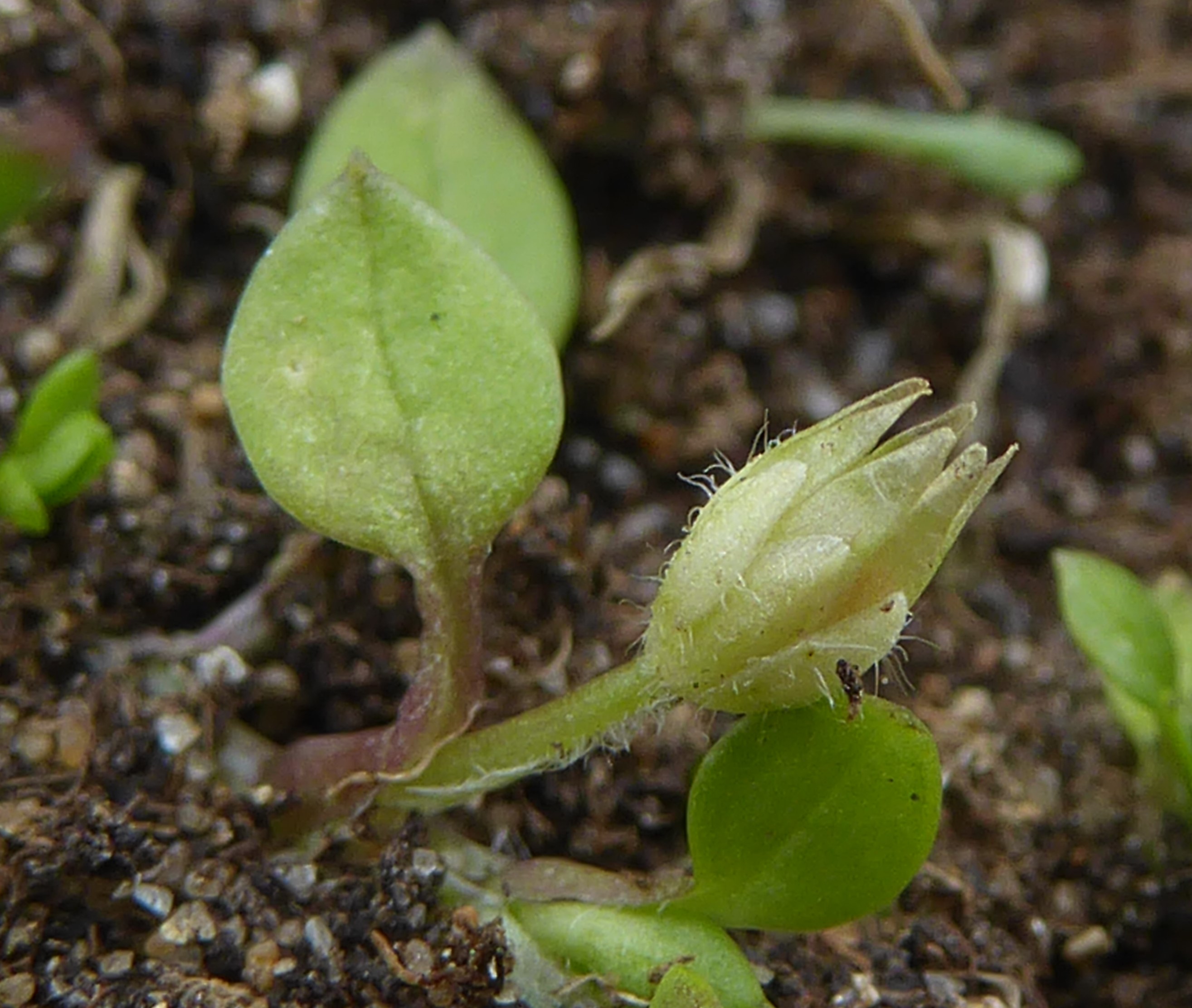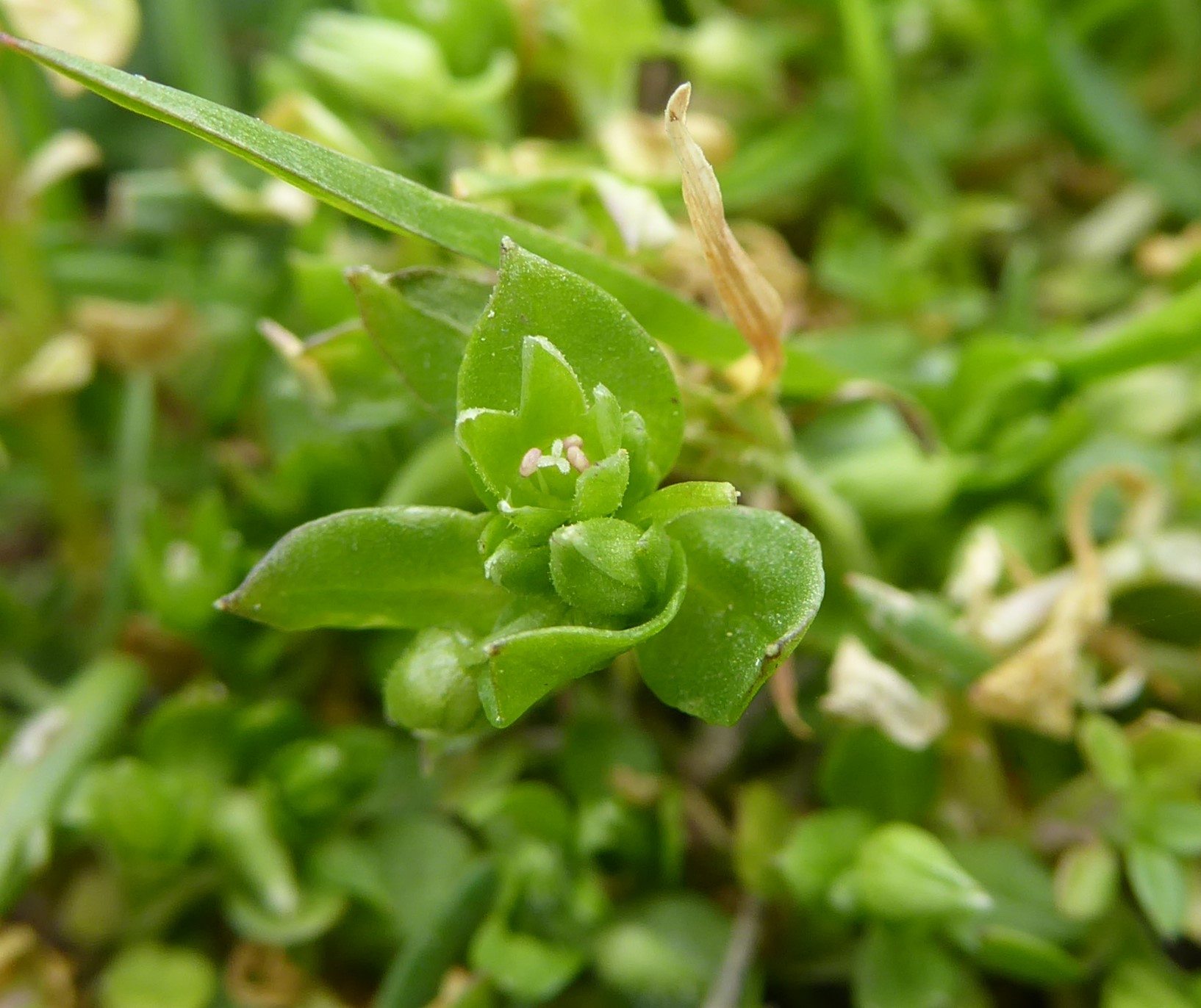Stellaria Apetala on:
[Wikipedia]
[Google]
[Amazon]
''Stellaria apetala'' (syn. ''S. pallida''), lesser chickweed, is an annual plant, annual herbaceous plant in the flowering plant family Caryophyllaceae. It occurs in short, sandy grassland by the sea and, less often, in similar habitat inland. It is native to Europe and is well established as an introduced species worldwide.

 Flowering occurs in the early spring, February-May in Northern Europe. The inflorescences are terminal and consist of a short Cyme (botany), cyme of up to six flowers, which are small, 2–3 mm in diameter. There are four or five hairy oval/lanceolate green sepals 2–3.5 mm long. Most flowers have no petals at all, but a small proportion have five deeply bifid green/scarious petals about 1 mm longer than the sepals, which never open widely. There are usually between one and three stamens, sometimes none, with grey-violet anthers, and three Style (botany), styles.
Flowering occurs in the early spring, February-May in Northern Europe. The inflorescences are terminal and consist of a short Cyme (botany), cyme of up to six flowers, which are small, 2–3 mm in diameter. There are four or five hairy oval/lanceolate green sepals 2–3.5 mm long. Most flowers have no petals at all, but a small proportion have five deeply bifid green/scarious petals about 1 mm longer than the sepals, which never open widely. There are usually between one and three stamens, sometimes none, with grey-violet anthers, and three Style (botany), styles.
 The fruits are formed a week or two after flowering and consist of an oval green capsule about 3 mm long, which remains surrounded by the sepals. Each fruit contains about 6-8 yellowish-brown disc-shaped seeds which are released when the tip of the fruit opens by six spreading teeth. The seeds are 0.5–0.8 mm in diameter, with a ring of small, blunt tubercles around the rim.
''Stellaria apetala'' is self-pollinating and, because the flowers do not open widely, is often cleistogamous.
The fruits are formed a week or two after flowering and consist of an oval green capsule about 3 mm long, which remains surrounded by the sepals. Each fruit contains about 6-8 yellowish-brown disc-shaped seeds which are released when the tip of the fruit opens by six spreading teeth. The seeds are 0.5–0.8 mm in diameter, with a ring of small, blunt tubercles around the rim.
''Stellaria apetala'' is self-pollinating and, because the flowers do not open widely, is often cleistogamous.



 The flowers are Cleistogamy, cleistogamous and are not visited by pollinating insects. The UK'
The flowers are Cleistogamy, cleistogamous and are not visited by pollinating insects. The UK'
Database of Insects and their Food Plants
lists no species that feed on lesser chickweed, although there are several Fly, Diptera and other insects which are known to attack chickweeds (''Stellaria'' spp.) generally. Its Indicator value, Ellenberg values in Britain are L = 7, F = 4, R = 4, N = 4, and S = 0, which signifies a brightly lit situation with dry, somewhat acidic soil, low fertility and no salt.
Description
Lesser chickweed is a low-growing, patch-forming annual herb with a distinctly yellowish-green colour. It has a dense, spreading root mat which makes it difficult to dislodge from the ground. The stems, which are sometimes tinged purple, spread out along the ground without rooting at the nodes, and lengthen to about 10 cm long. They are terete and glabrousness (botany), glabrous, with a single line of hairs down one side, which alternates at the nodes. The leaves are opposite, pale green and ovate, 4-7 mm long by 2-3 mm wide, with a pale green or sometimes purple hydathode at the pointed tip and stoma, stomata on both sides. The Petiole (botany), petioles are flattened, hairy and about 3-5 mm long, except at the tip of the stem, where the leaves appear Sessility (botany), sessile.
 Flowering occurs in the early spring, February-May in Northern Europe. The inflorescences are terminal and consist of a short Cyme (botany), cyme of up to six flowers, which are small, 2–3 mm in diameter. There are four or five hairy oval/lanceolate green sepals 2–3.5 mm long. Most flowers have no petals at all, but a small proportion have five deeply bifid green/scarious petals about 1 mm longer than the sepals, which never open widely. There are usually between one and three stamens, sometimes none, with grey-violet anthers, and three Style (botany), styles.
Flowering occurs in the early spring, February-May in Northern Europe. The inflorescences are terminal and consist of a short Cyme (botany), cyme of up to six flowers, which are small, 2–3 mm in diameter. There are four or five hairy oval/lanceolate green sepals 2–3.5 mm long. Most flowers have no petals at all, but a small proportion have five deeply bifid green/scarious petals about 1 mm longer than the sepals, which never open widely. There are usually between one and three stamens, sometimes none, with grey-violet anthers, and three Style (botany), styles.
 The fruits are formed a week or two after flowering and consist of an oval green capsule about 3 mm long, which remains surrounded by the sepals. Each fruit contains about 6-8 yellowish-brown disc-shaped seeds which are released when the tip of the fruit opens by six spreading teeth. The seeds are 0.5–0.8 mm in diameter, with a ring of small, blunt tubercles around the rim.
''Stellaria apetala'' is self-pollinating and, because the flowers do not open widely, is often cleistogamous.
The fruits are formed a week or two after flowering and consist of an oval green capsule about 3 mm long, which remains surrounded by the sepals. Each fruit contains about 6-8 yellowish-brown disc-shaped seeds which are released when the tip of the fruit opens by six spreading teeth. The seeds are 0.5–0.8 mm in diameter, with a ring of small, blunt tubercles around the rim.
''Stellaria apetala'' is self-pollinating and, because the flowers do not open widely, is often cleistogamous.
Taxonomy
''Stellaria apetala'' forms part of a complex that also includes ''Stellaria media, S. media'' and ''Stellaria neglecta, S. neglecta''. It was first described by Bernardino da Ucria, Ucria in 1796. In 1828, Barthélemy Charles Joseph Dumortier, Du Mortier, describing a form found in Belgium, applied the name ''Alsine pallida'', which Louis Alexandre Henri Joseph Piré, Piré (1863) transferred to the genus ''Stellaria''. The taxonomic status of ''Stellaria apetala'' (Dumort.) Piré has been confused. Dandy (1958) and Clapham, Tutin and Warburg (1962) adopted the name ''Stellaria pallida'' but while Clapham et al. treated ''S. apetala'' Ucria as a synonym, Dandy considered this to be a synonym of ''S. media'' L., as also did Chater and Heywood. Whitehead and Sinha, having failed to locate any specimens matching the description in the ''Flora Europaea'', concluded that ''S. apetala'' Ucria or ''S. apetala'' auct. could be regarded as synonyms of ''S. pallida'' (Dumort.) Piré. ''Stellaria pallida'' is now considered a junior synonym of ''Stellaria apetala''. Its chromosome number is 2n = 22. The name ''Stellaria'' is from the Latin "stella", for a star, and describes the appearance of the flowers of plants in this genus (not so much this particular species). The prefix "a-" derives from the Ancient Greek, and means "without" or "lacking" and therefore refers to the absence of petals in most specimens. The synonym ''pallida'' comes from the Latin pallens, pallidus = pale, and is most likely a reference to the yellowish colour of the foliage.Identification
Lesser chickweed is easily confused with Stellaria media, common chickweed, especially small plants without petals (''Stellaria media'' var. ''apetala'' Gaudin). The only certain way to separate them is by a chromosome count, but the following field characters are useful. Lesser chickweed is yellowish, not bright green; the sepals are only up to 3 (not 5) mm long; it has 3 or fewer stamens (''media'' has 3-10); the fruiting capsules are less than 5 mm long; the fruiting pedicels are short and not reflexed; and the ripe seeds are less than 0.9 mm long.


Distribution and status
''Stellaria apetala'' has a widespread, though local, distribution across Europe, from southern Spain and the Mediterranean islands to Sápmi, Lapland, and from the British Isles to Ukraine. In North America it is found as an introduced species from Ontario, Canada, to Mexico and throughout the United States, from the east coast (Virginia, North Carolina, North and South Carolina, and Florida) to the west coast (California and Washington (U.S. state), Washington). It is also established in many other countries worldwide. In the European Union its threat status has not yet been evaluated, but in Britain it has been designated Least-concern species, Least Concern.Habitat and ecology
The main habitat for this species is in sandy and gravelly grassland close to the shore. It grows on well-drained soils and is able to withstand a fair amount of trampling and grazing. Away from the sea it occurs in sandy areas and is found on woodland rides, waste ground and eroded hillsides. In Europe it is often found growing under the shade of Scots Pine in woodland on light glacial sands, whereas in Britain it often occurs in the distinctive British National Vegetation Classification, U1 ''Rumex acetosella'' grassland, where it is sometimes considered an axiophyte of species-rich habitat. The flowers are Cleistogamy, cleistogamous and are not visited by pollinating insects. The UK'
The flowers are Cleistogamy, cleistogamous and are not visited by pollinating insects. The UK'Database of Insects and their Food Plants
lists no species that feed on lesser chickweed, although there are several Fly, Diptera and other insects which are known to attack chickweeds (''Stellaria'' spp.) generally. Its Indicator value, Ellenberg values in Britain are L = 7, F = 4, R = 4, N = 4, and S = 0, which signifies a brightly lit situation with dry, somewhat acidic soil, low fertility and no salt.
References
{{Taxonbar, from1=Q11085761, from2=Q160076 Stellaria, apetala